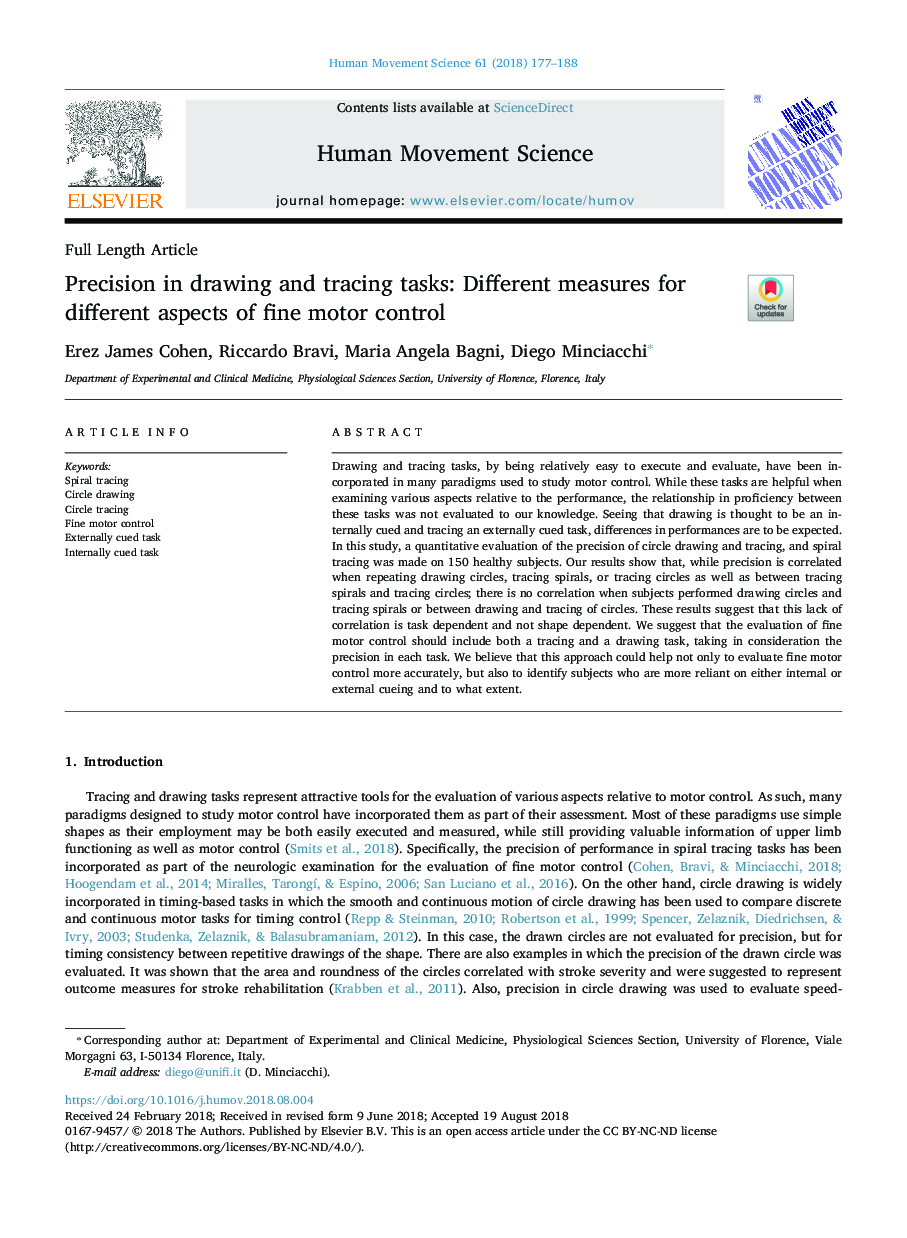| کد مقاله | کد نشریه | سال انتشار | مقاله انگلیسی | نسخه تمام متن |
|---|---|---|---|---|
| 11004533 | 1474203 | 2018 | 12 صفحه PDF | دانلود رایگان |
عنوان انگلیسی مقاله ISI
Precision in drawing and tracing tasks: Different measures for different aspects of fine motor control
ترجمه فارسی عنوان
دقت در وظایف طراحی و ردیابی: اقدامات مختلف برای جنبه های مختلف کنترل موتور خوب
دانلود مقاله + سفارش ترجمه
دانلود مقاله ISI انگلیسی
رایگان برای ایرانیان
کلمات کلیدی
ردیابی اسپیرال، طراحی دایره، ردیابی دایره، کنترل دقیق موتور وظیفه خارجی وظیفه داخلی
ترجمه چکیده
وظایف طراحی و ردیابی، با نسبتا آسان برای اجرای و ارزیابی، در بسیاری از پارادایم های مورد استفاده برای مطالعه کنترل موتور، گنجانده شده است. در حالیکه این وظایف هنگام بررسی جنبه های مختلف نسبت به عملکرد مفید است، ارتباط بین مهارت های بین این وظایف به دانش ما ارزیابی نشده است. تصور می شود که این نقاشی به عنوان یک سؤال درونی و ردیابی یک کار خارج از چارچوب، انتظار می رود تفاوت های عملکردی. در این مطالعه، یک بررسی کمی از دقت طراحی و ردیابی دایره و ردیابی مارپیچ روی 150 فرد سالم انجام شد. نتایج ما نشان می دهد که در حالی که دقیق در هنگام تکرار حلقه های رسم، ردیابی مارپیچی ها یا ردیابی حلقه ها و نیز بین حلقه های ردیابی و حلقه های ردیابی همبستگی وجود دارد؛ در هنگام انجام تکالیف، حلقه ها و ردیابی مارپیچی یا بین کشیدن و ردیابی دایره ها، همبستگی وجود ندارد. این نتایج نشان می دهد که این عدم همبستگی وابسته به کار و وابسته به شکل نیست. ما پیشنهاد می کنیم که ارزیابی کنترل دقیق موتور باید شامل ردیابی و یک کار رسم باشد، با توجه به دقت در هر کار. ما بر این باوریم که این رویکرد می تواند نه تنها برای ارزیابی دقیق تر موتور کنترل دقیق، بلکه برای شناسایی افرادی که بیشتر بر پایه های داخلی یا خارجی و به چه میزان وابسته هستند، کمک می کند.
موضوعات مرتبط
علوم زیستی و بیوفناوری
علم عصب شناسی
علوم اعصاب شناختی
چکیده انگلیسی
Drawing and tracing tasks, by being relatively easy to execute and evaluate, have been incorporated in many paradigms used to study motor control. While these tasks are helpful when examining various aspects relative to the performance, the relationship in proficiency between these tasks was not evaluated to our knowledge. Seeing that drawing is thought to be an internally cued and tracing an externally cued task, differences in performances are to be expected. In this study, a quantitative evaluation of the precision of circle drawing and tracing, and spiral tracing was made on 150 healthy subjects. Our results show that, while precision is correlated when repeating drawing circles, tracing spirals, or tracing circles as well as between tracing spirals and tracing circles; there is no correlation when subjects performed drawing circles and tracing spirals or between drawing and tracing of circles. These results suggest that this lack of correlation is task dependent and not shape dependent. We suggest that the evaluation of fine motor control should include both a tracing and a drawing task, taking in consideration the precision in each task. We believe that this approach could help not only to evaluate fine motor control more accurately, but also to identify subjects who are more reliant on either internal or external cueing and to what extent.
ناشر
Database: Elsevier - ScienceDirect (ساینس دایرکت)
Journal: Human Movement Science - Volume 61, October 2018, Pages 177-188
Journal: Human Movement Science - Volume 61, October 2018, Pages 177-188
نویسندگان
Erez James Cohen, Riccardo Bravi, Maria Angela Bagni, Diego Minciacchi,
